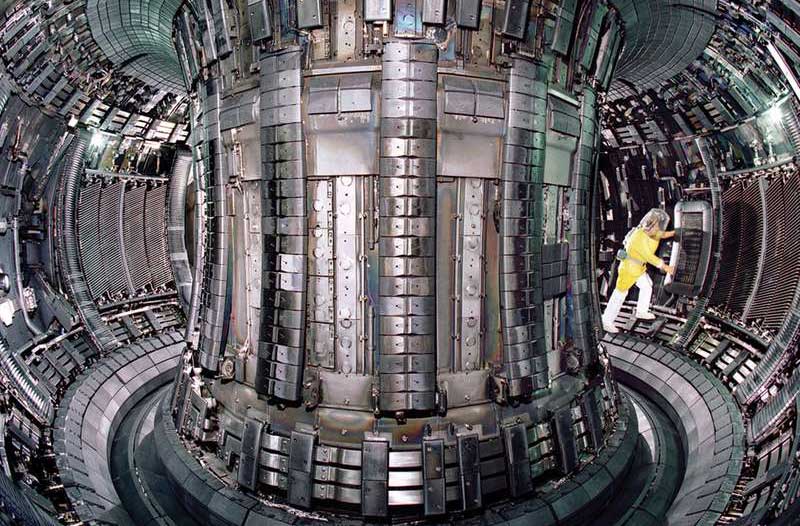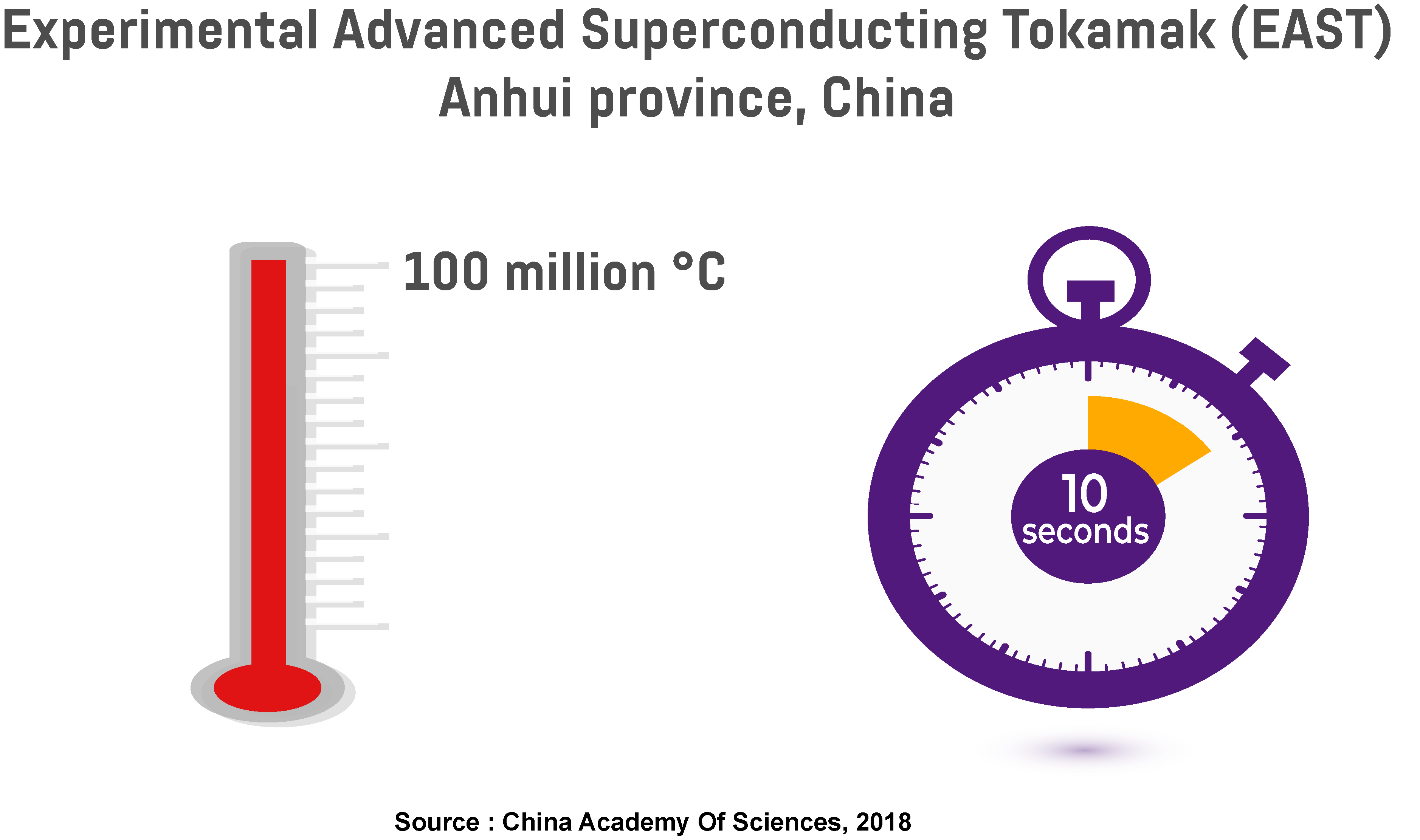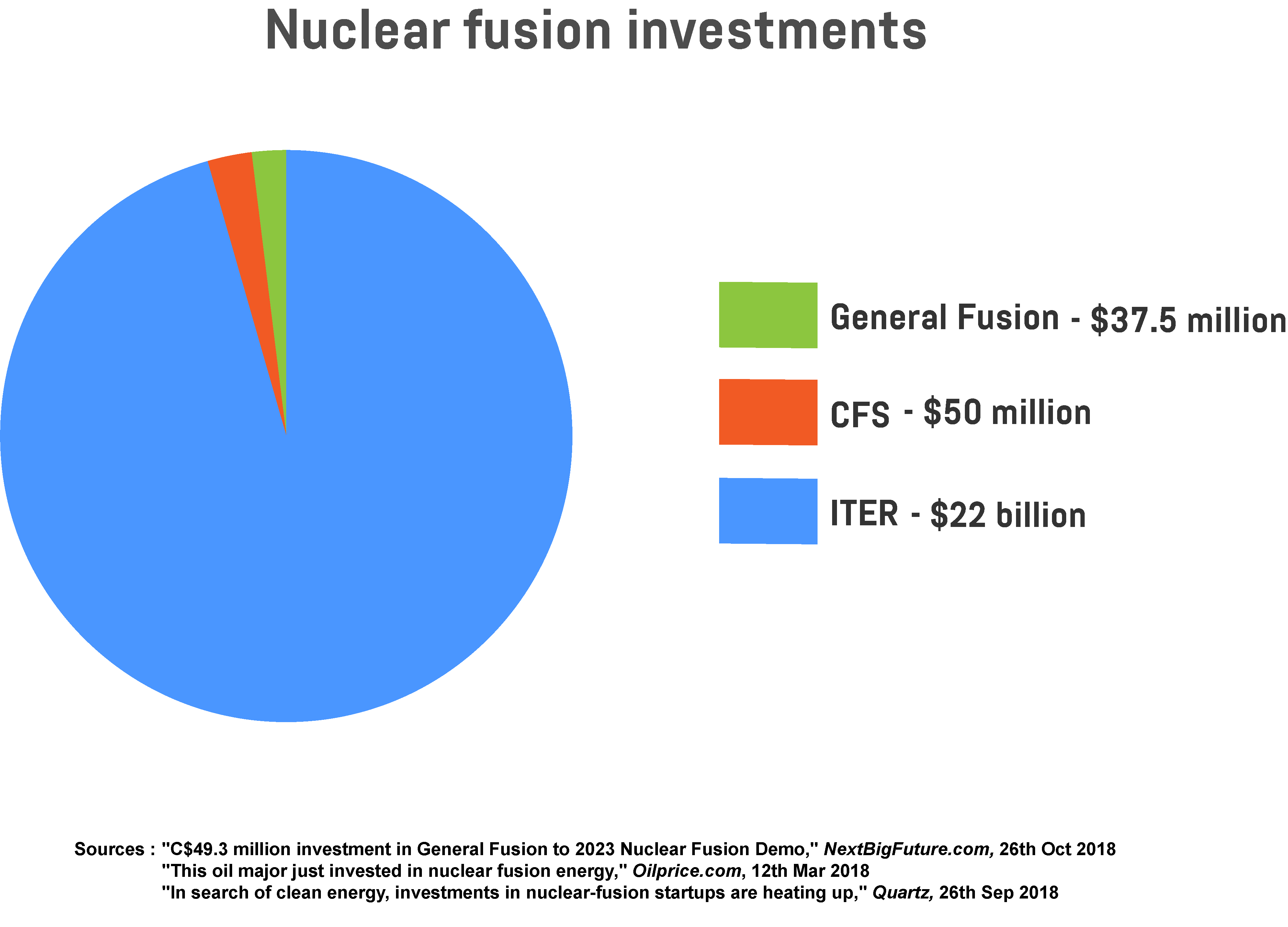- The science behind nuclear fusion
- Is the long-held dream of unlimited clean energy coming true anytime soon?
- China builds an artificial sun – and it’s almost seven times hotter than the ‘real deal’
- Nuclear fusion investments are gaining steam
- What are the pros and cons of nuclear fusion?
- A glimpse into the future
Global energy demand is growing, and we still heavily depend on fossil fuels for energy, polluting the environment and worsening climate change. To move away from fossil fuels and increase our energy production capacity, countries around the world are exploring ways to generate electricity and mitigate climate change through renewables such as solar and wind. But the biggest problem with these energy sources is their intermittent nature. In other words, when the sun isn’t shining and the wind isn’t blowing, there’s no energy being generated.
An effective alternative is nuclear energy, but traditional nuclear plants produce energy through fission, which creates a lot of radioactive waste and can lead to a catastrophic meltdown – just remember Fukushima and Chernobyl. That’s why scientists have been attempting to develop nuclear fusion plants for a while now, hoping to tap into this limitless source of clean energy. Nuclear fusion is one of the most promising options for future energy production, but it remained just a theoretical concept for years, with many failed attempts at producing stable plasma. However, recent breakthroughs have brought us a couple of steps closer to making sustained nuclear fusion a reality.
The science behind nuclear fusion
So, what exactly is nuclear fusion? To find the answer, let’s take a look at the star in our solar system – the sun. Fusion is an atomic reaction that powers stars like our sun by fusing hydrogen atoms under immense pressure to form helium. When these atoms fuse together, a massive amount of energy is released – energy that we see as light and feel as heat. For this reaction to happen, hydrogen atoms must be heated to extremely high temperatures (we’re talking at least 15 million degrees Celsius in the sun), after which they turn into plasma, a hot ionised gas, also called “the fourth state of matter”. To create stable plasma on Earth, however, we need to use hydrogen isotopes – usually deuterium and tritium – but at much, much higher temperatures – more than 100 million degrees Celsius. Achieving such temperatures on Earth, however, is extremely difficult, which is why we’re still not enjoying the benefits of nuclear fusion.
Over the past few years, scientists have explored two main ways to achieve stable plasma. The first one, called magnetic confinement, is based on using magnetic fields to constrain the plasma. This is usually done with doughnut-shaped reactors such as tokamaks and stellarators. In the second approach, dubbed inertial confinement, researchers use laser beams to heat the outer layer of a material that then explodes, causing an “inward-moving compression front or implosion” and heating the inner part of the material, creating conditions for fusion to occur.
Is the long-held dream of unlimited clean energy coming true anytime soon?
Power generation from fusion is still in the research stage, but scientists around the world are putting in a lot of effort to make this innovation feasible as soon as possible. In 2017, the Dutch Institute for Fundamental Energy Research (DIFFER) published a study in which the team revealed a promising solution for future fusion reactors. The issue they wanted to solve is how to make fusion reactors intact and continuous. Due to high temperatures, a reactor’s walls usually need to be replaced after a few days, which means the fusion reaction needs to be stopped. But the team from DIFFER, in partnership with the University of Gent, conducted an experiment in which they covered the wall with a thin layer of liquid metal. As the plasma inside the wall heats up, it creates a cloud of vapour above the liquid layer. This vapour catches the energy from the plasma and spreads it over a larger area, which keeps the wall surface temperature stable.

Besides the Netherlands, the UK has also made an important breakthrough in nuclear fusion research. In 2018, a UK-based company, and one of the leading nuclear fusion ventures in the world, Tokamak Energy, announced its reactor, ST40, achieved plasma temperature of more than 15 million degrees Celsius. However, to control fusion reactions on Earth, ST40 needs to achieve plasma temperature of 100 million degrees Celsius, which is nearly seven times hotter than the sun’s core. In their last experiment, the team at Tokamak Energy used ‘merging compression’, a process in which energy is released in the form of rings containing plasma. These rings smash into one another, producing magnetic fields to confine the plasma. ST40 is the third reactor produced by Tokamak Energy, and compared to other reactors, it’s a lot smaller. Although the journey of making nuclear fusion commercially available is filled with engineering challenges and high investments, the company is on a mission to make it feasible by 2030. “The world needs abundant, controllable, clean energy,” says the company’s co-founder, David Kingham.
Another important discovery comes from a team of US and German researchers. They used the Wendelstein 7-X (W7-X) stellarator in Germany to achieve balanced high-performance plasma. A stellarator is similar to a tokamak. The difference between these two is that the stellarator operates continuously with lower input power, but it’s harder to build because it’s ‘twisty’. To optimise future stellarators, the scientists have conducted experiments using a system comprised of “magnetic ‘trim’ coils” and demonstrated its ability to ensure a balanced plasma and improve the overall performance of the Wendelstein reactor.
China builds an artificial sun – and it’s almost seven times hotter than the ‘real deal’
China is also stepping up its game in the nuclear fusion race. During an experiment conducted at the Institute of Plasma Physics in China’s Anhui province, scientists managed to maintain a plasma temperature of 100 million degrees Celsius for around 10 seconds, which might not seem like a long time, but it’s a very significant achievement on the path to sustained nuclear fusion.

This artificial sun is basically a round metal reactor called Experimental Advanced Superconducting Tokamak (EAST). To keep the plasma at high temperatures, EAST relies on magnetic confinement and requires a lot of energy input. For instance, in the latest experiment, China’s artificial sun needed more than 10 megawatts of energy just to get started, which is enough to power 1,640 homes in the US for a year. China’s next step, though it might seem rather ambitious, will be developing a more powerful and bigger reactor to maintain plasma temperature for much longer than just 100 seconds, while requiring a lower energy input.
Producing power with minimum energy input is the main goal of another fusion project. The International Thermonuclear Experimental Reactor (ITER) is considered to be the biggest nuclear fusion project in the world, supported by 35 countries. ITER’s construction began in 2010 in southern France, on a site that will consist of 39 buildings, with the seven-storey Tokamak Building as the main facility. The reactor will be activated in 2025, when it should become the first fusion reactor to generate more power than it consumes. The reactor is expected to use an energy input of 50 megawatts, while generating 500 megawatts of energy for at least six or seven minutes.
Currently, nuclear fusion is still regarded as an expensive experiment, but MIT scientists are also on a mission to make fusion a viable energy source. In collaboration with a private startup, Commonwealth Fusion Systems (CFS), they’re planning to use high-temperature superconductors to develop a fusion reactor that will produce more energy than it needs to start the reaction. Such superconducting materials could create powerful magnetic fields to confine plasma at high temperatures, but also reduce the amount of energy required for the reaction to begin. According to Bob Mumgaard, the CEO of CFS, “The aspiration is to have a working power plant in time to combat climate change.” As the team believes, this could happen in 15 years.
Nuclear fusion investments are gaining steam
MIT’s efforts to make fusion power widely available attracted the attention of an Italian gas and oil company, Eni. In 2018, Eni revealed its plan to invest $50 million into CFS’ and MIT’s research. Companies and startups all over the world are pouring billions of dollars into research to prove that fusion is a feasible source of clean energy.

For instance, countries working on ITER in France will spend $22 billion to build the tokamak reactor. Furthermore, the Canadian government made an investment worth $37.5 million in a nuclear fusion tech company called General Fusion. Besides helping General Fusion to develop ground-breaking technology that will transform the world’s energy supply, the investments will also lead to 400 new jobs.
What are the pros and cons of nuclear fusion?
Based on the amount of money that’s being invested in nuclear fusion projects, it’s clear that it’s expensive business. For instance, it costs $15,000 per day to turn on the EAST reactor in China, and a few million dollars are nothing in the fusion world. Besides money, fusion projects take time, too, and some believe that developing a commercial fusion reactor will always be a few decades away. So, is it worth it? Since fusion energy could make us less dependent on fossil fuels and help us mitigate climate change, it’s definitely worth the price.
Clearly, nuclear fusion seems like an ideal energy source, but nuclear accidents that happened in the past, such as the Fukushima meltdown in 2011 and the Chernobyl nuclear disaster in 1986, have raised concerns regarding the overall safety of nuclear power, and here’s why. 80 per cent of fusion energy is released in the form of neutrons. Once these particles smash into reactor components, they leave radioactive waste. Although the amount of radioactive waste produced during a fusion reaction is much lower than with fission, if it’s accidently released into the air or water, it’s still dangerous and can remain radioactive for 120 years. What makes nuclear fusion safer and reduces the risk of a catastrophe is that it can be easily controlled and stopped when necessary. In case a malfunction occurs during the reaction, the plasma would cool and a meltdown would be avoided. Even so, safety shouldn’t be neglected, and companies and researchers involved in nuclear fusion projects need to take precautionary measures, test their technology, and prove it’s clean and sustainable.
A glimpse into the future
Since the global population continues to increase and cities are expected to become even more crowded, energy demands will be significantly higher, too, and our fossil fuel dependence will only worsen the effects of ongoing climate change. All this seems like an introduction to an apocalypse, but the future doesn’t necessarily need to be that bad. Not if scientists provide us with an abundant clean energy source such as nuclear fusion.
Fusion reactors could produce enough energy to power ships and aircraft and even speed up space travel. Though some predict fusion power will become commercially available by 2050, innovative ideas and new technologies could accelerate the development of this technology. As Mike Delage, the chief technology officer at General Fusion, notes, “if you have the knowledge to build a power plant, you can build it anywhere”. Whether the commercialisation of fusion is 15 or 30 years away, when it arrives, it will certainly disrupt the fossil fuel industry and traditional energy systems. Lastly, harnessing fusion power could result in some economic implications as well, because countries that develop and commercialise it could enjoy considerable benefits from cheaper electricity.
Share via:


